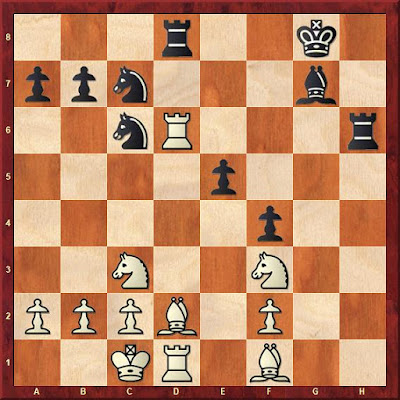One of the relatively lesser-known chess columns was that of Zmanim ("The Times"), a smaller newspaper in Israel than the major papers like Davar, Al Ha'mishmar, and others. The editor of the chess column was A. A. Mandelbaum. This column was brought to our attention from a frequent correspondent. From Zmanim we offer the followin game of the young Zadok Domnitz, when he played in the IDF's team in the Isreali premier league against the older Avraham Labounsky.
Domnitz, Zadok - Labounsky, Avraham
Pirc Defense (B07)
Israeli Premier (Aleph) League, 1954
Source: Zmanim, 13.8.54, p 8S
Annotator: A. A. Mandelbaum
1. e4 d6 2. d4 Nf6 3. Nc3 g6 4. Be2 Sharper and more
promising is 4. f4. 4... Bg7 5. Be3 O-O?
Routine. Since White didn't apply
the usual h3, Nf3, etc.
attack and left himself more flexibility in pursuing the attack, Black should
have used delaying tactics and defer the castling to a more appropriate time. 6. h4 e5 Needed is 6... c5 7. dxc5 Qa5 8. cxd6 Nxe4 9. dxe7 Re8 10. Bd2 Nxc3 with compensation for the pawn 7. d5 b5! 8. Bxb5 (8. Nxb5 Nxe4) 8... Nxe4 9. Nxe4 Qa5+ 10. Nc3 Bxc3+ 11. bxc3 xb5 and with the threat of Ba6 Black has nothing to fear. 7. d5 c6 8. g4 Qa5? Correct was 8... cxd5 9. exd5 Qa5. 9. Bd2 Qb6? 9... Qc7 immediately is better. 10. g5 Ne8 11. h5 f5?
Weakens the g8-a2 diagonal, and loses immediately. More consistent with the position is 11... Nc7. 12. dxc6 Be6 Bc4+ must be stopped at all costs.13. Be3 Qxc6 13... Qxb2 is forbidden due to 14. Na4 Qa3 (14... Qb4+ 15. c3 and wins) 15. cxb7 and wins. 14. Bb5 Qc7 Better is 14... Qc8. 15. hxg6 hxg6 16. exf5 gxf5 17. Qh5 Nc6 18. Qg6 Qc8 19. Rh6 f4?
Up to now all of Black's moves were forced, but now 19... Nd4 would allow longer resistance. For example 20. Bd3 Bc4, Or 20. O-O-O Nxb5 21. Nxb5 f4 22. Nxd6 Bf5! 23. Nxc8 Bxg6 24. Ne7+ Kf7, etc. 20. Bd3! Threatens Rh8+ followed by Qh7#. 20... Rf5 21. Qxe6+ Enough to win, as we shall see. 21... Qxe6 22. Rxe6 Rxg5 The fight to regain the piece is hopeless. 23. Nf3 Rh5 24. Bd2 Rh1+ 25. Bf1 Rd8 26. O-O-O The Re6 is not in danger. 26... Nc7 27. Rxd6 Rh6
The Re6 rook was protected indirectly: 27... Rxd6 28. Bc4+ And wins the Rh1. 28. Rxd8+ Nxd8 29. Bxf4 A double attack on the Nd8 and Rh6. 29... exf4 30. Rxd8+ Bf8 31. Bc4+ Kh7 32. Rd7+ Black resigns (0-1).

















